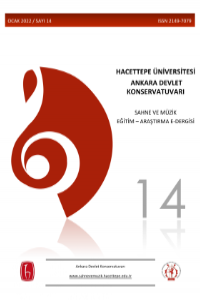MÜZİK TARİHİNDE KLASİK-ROMANTİK İKİLEMİ: FRANZ SCHUBERT’İN DO-MİNÖR IMPROMPTU’SU (D.899 NO.1) ÜZERİNDEN BİR İNCELEME
Tarihin dönemlendirilmesi, araştırma ve eğitim açısından bazı kolaylıklar sağlamaktadır. Batı müziği tarihi de kendi içinde belirli tarihsel dönemlere ayrılır. Bazen dönemler birbirlerinin içine karışmakta ve sağlıklı bir dönemlendirme yapmak zorlaşmaktadır. Örneğin, geçiş dönemlerinde yaşamış kimi bestecilerin eserlerinin hangi döneme ait olduğunu saptamak, söz gelimi bu eserlerin klasik mi yoksa romantik mi olduğu ya da bestecinin hangi eserlerinin çağdaş ve hangisinin geleneksel üsluplara daha bağlı olduğu konusu güncelliğini korumaktadır. Bu konuya ilişkin akla gelen ilk bestecilerden biri Franz Peter Schubert (1797-1828)’tir. Schubert, eserlerinde pek çok yeni form ve stile yer vererek, Klasik ve Romantik dönemler arasında özel bir konuma sahip olmuştur. Bu çalışmada, Batı müziğinde Klasik ve Romantik ikilemini ele alan literatüre başvurulmuş ve örnek olarak Franz Schubert’in Do-minör Impromptu’su (D.899 No.1), Klasik-Romantik ikilemi açısından incelenmiştir. Ulaşılan sonuçların, müzik tarihi ve piyano literatürü bakımından daha geniş bir bakış açısı sunarak müziğin teorik, pratik ve estetik yönleriyle ilgilenenlere katkı sağlayacağı düşünülmektedir.
Anahtar Kelimeler:
Franz Schubert, Klasisizm, Romantizm, Impromptu, stil
THE CLASSIC-ROMANTIC DILEMMA IN THE HISTORY OF MUSIC: AN OBSERVATION ON (D.899 NO.1) C-MINOR IMPROMPTU OF FRANZ SCHUBERT
The periodization of history allows for a focused approach to research and education. The history of Western music is also divided into certain historical periods. In the context of Western music, the history of this discipline is also divided into specific historical periods. However, the transition between these periods can be difficult to define, as some composers lived during transitional times and it is not always clear whether their works should be considered classical or romantic, or if they contain elements of both styles. One of the first composers that come to mind in this regard is Franz Peter Schubert (1797-1828). Schubert's works contain elements of both the Classical and Romantic periods, as he incorporated many new forms and styles into his compositions. In this study, the literature on the Classical and Romantic dichotomy in Western music is consulted and Franz Schubert's Impromptus in C minor (D.899 No.1) is analyzed in terms of the Classical-Romantic dilemma. It is thought that the results will contribute to those interested in the theoretical, practical, and aesthetic aspects of music by providing a broader perspective in terms of music history and piano literature.
Keywords:
Classicism, Romanticism, style,
___
- Adler, G., Mugglestone, E., & Yalınkılıç, E. (2022). Modern Müzikolojinin Doğuşu. Sahne ve Müzik, 26-27.
- Aktüze, İ. (2010). Ansiklopedik Müzik Sözlüğü. İstanbul: Pan Yayıncılık.
- Apel, W. (1974). Harvard Dictionary of Music (8th ed.). Cambridge, Massachusetts: The Belknap Press of Harvard University Press.
- Bar-Elli, G. (2013). Schubert: Impromptus. Retrieved from http://www.bar-elli.co.il/
- Blume, F. (1970). Classic And Romantic Music. New York: W.W.Norton&Company.
- Cangal, N. (2011). Müzik Formları. Ankara: Arkadaş Yayınevi.
- Dahlhaus, C. (1974). Romantik und Biedermeier. Zur musikgeschichtlichen Charakteristik der Restaurationszeit. Archiv Für Musikwissenschaft, 31(1), pp. 22-41. doi:10.2307/930168
- Einstein, A. (1947). Music in the Romantic Era. New York: W.W. Norton.
- Einstein, A. (1981). Schubert A Musical Portrait. New York: Da Capo Press.
- Etymonline. (2022, 11 19). Retrieved from https://www.etymonline.com/word/classic
- Gazimihal, M. (1959). Musiki Sözlüğü. İstanbul: Milli Eğitim Basımevi.
- Goff, J. L. (2015). Must We Divide History Into Periods? New York: Columbia University Press.
- Göktepe, M. (2020). Romantizm Sanat Akımı ve Sanatçıları Üzerine Bir Değerlendirme. Journal of Arts, 3(1), 45-66. doi:10.31566/arts.3.005
- Grout, D. J., Burkholder, J. P., & Palisca, C. V. (2014). A History of Western Music. New York: W.W. Norton & Company.
- Grove, G. (1904). Dictionary of Music and Musicians. Massachusetts: Norwood Press.
- Ham, I. (2005). Franz Schubert's Impromptus D.899 and D.935: An Historical and Stylistic Study. University of Cincinnati.
- Hanson, A. M. (1985). Musical life in Biedermeier Vienna. Cambridge: Cambridge University Press.
- Kirkindale, U. (1980). The Source for Bach's "Musical Offering": The "Institutio Oratoria" of Quintilian. Journal of the American Musicological Society, 33(1), 88-141. doi:https://doi.org/10.2307/831204
- Longman Active Study Dictionary of English. (1991). Longman Active Study Dictionary of English. Essex: Longman Group.
- Molla, M. (1997). Schubert'in Solo Piyano Eserleri Üzerine Bir Araştırma. Yayımlanmamış Yüksek Lisans Tezi. İstanbul: Mimar Sinan Üniversitesi Sosyal Bilimler Enstitüsü Müzik Anasanat Dalı Piyano Programı.
- Oransay, G. (1977-1978). Musiki Tarihi ve Stil Bilgisi. Ankara: Yaygın Yükseköğretim Kurumu.
- Pamir, L. (1998). Müzikte Geniş Soluklar. İstanbul: Boyut Yayın Grubu.
- Plantinga, L. (1997). Classic and Romantic Beethoven and Schubert. In R. Erickson, Schubert's Vienna (pp. 81-97). Yale University Press/New Haven&London.
- Rosen, C. (1971). The Classical Style. Viking Press.
- Say, A. (2010). Müzik Ansiklopedisi. Ankara: Müzik Ansiklopedisi Yayınları.
- Schubert, F. (n.d.). Impromptus&Moment Musicaux. Berlin: G.Henle Verlag.
- Seaton, D. (2010). Ideas And Styles In The Western Musical Tradition 4th edition. Oxford: Oxford University Press.
- The Oxford English Dictionary. (1970). The Oxford English Dictionary (Vol. VIII). Oxford: Oxford University Press.
- Whittall, A. (1987). Romantic Music. New York: Thames and Hudson.
- Winckelmann, J. J. (2012). Antikçağ Sanat Tarihi. (O. Özügül, Trans.) İstanbul: Say Yayınları.
- Анатольевна, Т. А. (2017, 3 7). Стилистические особенности фортепианного творчества Ф. Шуберта. Retrieved from Образовательная социальная: https://nsportal.ru/
- Вульфиус, П. (1974). Классические и романтические тенденции в творчестве Шуберта. Mосква: Mузыка.
- Başlangıç: 2015
- Yayıncı: Hacettepe Üniversitesi
Sayıdaki Diğer Makaleler
HÜADK FOLKLOR ARŞİVİ: DERLEME FİŞLERİ: İSTANBUL 1957 (1951)
HÜADK FOLKLOR ARŞİVİ DERLEME FİŞLERİ: BAYBURT 1937
Ferhat ÇAYLI, Ahu KÖKSAL, Ozan CİVELEK, Türev BERKİ
HÜADK FOLKLOR ARŞİVİ DERLEME FİŞLERİ: ARTVİN (ÇORUH) 1950 DOSYASI
HÜADK FOLKLOR ARŞİVİ DERLEME FİŞLERİ: SAMSUN-HAVZA 1943
HÜADK FOLKLOR ARŞİVİ DERLEME FİŞLERİ: TUNCELİ 1944
Erdinç YALINKILIÇ, Sevinç KESER VAROL
HACETTEPE ÜNİVERSİTESİ ANKARA DEVLET KONSERVATUVARI FOLKLOR ARŞİVİ DERLEME FİŞLERİ: ÇANAKKALE 1947
